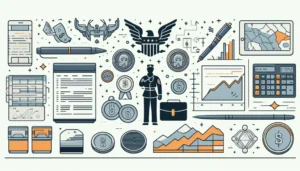This is a guest post from a listener of the podcast. He’d like to remain anonymous for now, so he’s going by the name MrSeabiscuitman. To further protect his identity some of the details in his story have been changed. We’ve used an asterisk (*) to point out when we have changed a detail.
My background
I’m currently 29yrs old, and up until the age of 23 had grown up and lived in Durham, New Hampshire*–a small town of about 20k people. Durham is a place where very few people leave. Some stay out of necessity, but most likely stay out of fear of the unknown.
With the exception of one of my 50+ extended family members, all of them still live within a 10-mile radius of where they grew up. I don’t mean to portray this as a bad thing, but I would like to make the point that due to this upbringing, I was not educated on, or exposed to, different varieties of monetary philosophies. In fact, most of my relatives all consist of the same background–lots of debt in the form of upside down mortgages, car payments, credit cards, etc. with minimal education and hardly any retirement savings.
Seeing these struggles made me realize that my education was my ticket to a comfortable life. Comfort became my goal. I couldn’t even assign a monetary value to it–I just knew that I wanted to live a life where money problems didn’t exist. As a result, I put a big emphasis on school. I went on to graduate top five in my class with other achievements including Basketball* Team Captain, Most Dedicated Award, Senior Science Award, National Honor Society Member and lots of volunteer work, along with working multiple part-time jobs.
I had, what many believed to be, the perfect resume for a college applicant. Being from low income with good grades, typically results in plentiful financial aid, which I did receive but initially did not take advantage of. You see, I somehow thought it would be a great idea to go to the same school as some of my friends. To make a long story short, the college we went to happened to be the worst financial option for me out of the seven schools I applied to. The school didn’t even have an engineering program, which is what I wanted to go to school for. After just one year, I decided to transfer to the University of New Hampshire*. I could commute, it was very affordable, and had the degree I wanted. Three and a half years later I graduated with approximately $26k in college debt, $18k of which was from my first year at the first school that didn’t really count for squat seeing as how I switched majors.
After graduating, I got a job with Company X* in April 2012, which required my wife and I to move from New Hampshire* to Missouri*. Our families thought we were crazy! But, I saw Company X’s decent starting salary of $60k in a very low cost of living area with good benefits including an employer 401k match of 10% as a very good starting point on my journey to becoming “comfortable”.
Over the last six years we’ve moved four times while I’ve held five different jobs with increasing responsibilities within the company. We’re actually about to move for the fifth time for my sixth job this June 2018. Along the way, we found Dave Ramsey.
We went on to eliminate our total college debt of $52k ($26k mine and $26k hers), max out my 401k and, accumulate a pretty good emergency fund. Life was good and I saw us as living “comfortably”. In fact, I even believed that with some disciplined savings and investing, I could probably retire early–maybe age 55ish.
But then a few amazing things happened. First and foremost, my wife and I had a baby girl in October 2017. She is amazing to say the least, and I started to think about life a little differently. With that said, I didn’t have a lot of time to think as you know kids can consume most of your attention, but luckily I was able to take advantage of something I saw as dumb and cumbersome–my current one-hour commute (two hours roundtrip).
This is where I found the FI community, and specifically ChooseFI. I’ve only been listening since February, but boy oh boy did the cylinders and pistons fire up in parts of my mind that I didn’t even know existed. Light bulb after light bulb came on and I quickly ran some numbers and realized that we could achieve FI in likely 5-7 years.
We have no debt, except for a house that we owe $151k on that our realtor is valuing at $210k. Our cars are nearly paid off (one is fully paid for and the other we owe $2,500 on at 0.89% interest–we could easily pay it off but I choose to invest) and we have about $215k invested between retirement and taxable accounts. This does not include our emergency fund of $20k. After we sell our house and move, we plan to rent for a while and invest any profits made from selling the house.
So, now that I’ve explained my background and current information, I’d like to elaborate on how ChooseFI has helped me.
Pre-tax retirement account advantages
Through work, I can either contribute after tax or before tax dollars to my 401k. After finding ChooseFI, I switched my contribution type to pre-tax and I’m now able to invest even more into taxable accounts after maxing out 401k!
Tax withholding changes
Now that I know a lot more about taxes, I realized that my wife and I were essentially providing the U.S. Government with a loan each year and would then receive a substantial tax refund check in the thousands of dollars’ area–I’ll ball park it at $5k to $6k. With the recent addition of the little one, this amount will get even higher with no changes.
So, I basically did some digging, got even deeper into rabbit poop, and made changes to my payroll deductions. Now we are looking to break even with the Government on an annual basis. This will allow us to receive and invest our hard-earned dollars on a monthly basis rather than waiting until the end of the year to throw it on a big purchase that we don’t need. This has equated to about $600 monthly that we are investing vs. waiting to blow in the form of a big check!
Index fund investing
Luckily, my company is already linked with Vanguard so that’s where my 401k dollars are held; however, I never had the courage to investigate and look into opening taxable accounts as I saw it as a difficult task. However, after listening to ChooseFI, as well as other FI podcasts, I opened up a taxable account and am now contributing to it monthly after maxing out 401k.
Understanding expense ratios and making changes
Like I said before, my 401k dollars are all invested through Vanguard funds. But after listening to ChooseFI discuss expense ratios, I went ahead and looked at my 401k funds and realized that my expense ratios were high for three (0.45, 0.60 and 0.84) of the six funds I was invested in. I have since removed the high expense funds and now just have the three index funds with low expense ratios of 0.035, 0.05 and 0.05.
Calculating/tracking net worth and savings rates
We weren’t doing this before, but with a little push from ChooseFI, and by reading some MMM articles, I now track a spreadsheet where I calculate these items. Since starting this FI journey in February, we are averaging a 59% Savings Rate!
Grocery savings
Using the $2/person/meal has been helpful and looking for different ways to cut grocery expenses has been sort of a game and fun at the same time. My wife and I bucket restaurant/eating out separate from groceries. With that said, we were still spending about $1,100 per month for both of us on just groceries!
We are extremely healthy eaters, and we still are, but last month (March) was the first time we took a hard stab at it and got our spending down to $749. For April, we hit $604. I think we’re still figuring out ways to get lower. We already had a Costco membership, but we also switched from Kroger to Walmart for many small items–you just can’t beat the prices.
If we remain at $600/month in groceries, it’s still an annual savings of $6,000 (Spending $600 vs. $1,100).
Investigating monthly fixed costs
I called our car insurance provider, Geico, and was able to reduce our monthly payment by about $35 by making some changes. For TV, I would prefer to eliminate cable altogether and just go with Netflix/Amazon Prime, but my wife, who stays at home with the baby, gets a lot of happiness from having cable. With that said, we will be switching from Direct TV to Sling.
Sling will only be $35/month vs. $95/month we were paying. Although I found we were stuck with Direct TV until May, after I investigated in February I did realize we still had HBO at $20/month on our account, which was free the first three months but was never deleted (fell into that trap), so we did go down from $95 to $75/month.
Also, since we are switching, I will no longer be purchasing Sunday NFL Ticket that I was stupidly paying about $400 annually for. I also found we were renting movies from Direct TV for an average rate of $14/month–this has stopped as well. So, from what I’ve mentioned on this bullet point alone we’ve saved on a monthly basis $35 (Geico), $20 (HBO), $40 (future Sling), $14 (Movie Renting) totaling $109 monthly or $1,308 annually. If you tack on $400 from Sunday NFL Ticket, that’s a total annual savings of $1,708!
Grooming
I started cutting my own hair. Heard this from one of the ChooseFI guests (Frugalwoods in Vermont) and also there’s an awesome MMM article out there pertaining to this. This results in $33 monthly haircut savings. Plus, $50 annually in hair gel that I no longer use now that I can cut my own hair and keep it really short. Total annual savings: $446.
MSRP rule
Basically, this is a rule I made up where I will never pay “full price” for most things moving forward. Prime example–my wife has been craving a night out/break from the little one. We don’t go out to eat often. My wife loves Macaroni Grill, which means I love Macaroni Grill, so I did a little research, signed up with Couponcabin.com, and used Coupon Cabin to buy a $75 Macaroni Grill gift card for $56.
By using Coupon Cabin’s site, I got 20% back ($11) from Coupon Cabin. I know this is a small example, but the “old me” would’ve just paid $75 at dinner. The “new me” only paid $56 for a $75 dinner and will get an additional $11 back.
My wife and I are getting on the same page
We’ve always had a solid relationship, but over the past six years my wife has made it known that at some point she wants to move back home. I was never able to get on board with that, but I’ve always known that I will eventually give in. Now we have a FI goal and I now see the value in being near loved ones, especially when I can devote 100% of my time to my friends and family if I choose.
Episode 068 with Andy Hill, has also shown me where I’ve gone down the rabbit hole in some ways where my wife hasn’t. This prompted me to call my wife yesterday to apologize about that. The podcast provided some really good perspective on how I can better include my wife in our decisions.
Other items
Career hacking with ESI
Like Mr. ESI, I have also maintained an average annual pay increase of just over 8%! I love his steps about results, being likeable, etc. Definitely made me think a little more about how I approach work. Specifically, how I’m seen in meetings.
The side hustle
I would love blogging to become my side hustle; however, earning additional income from this is not my top priority. I’d rather focus on inspiring others, but side income could be an additional benefit.
The power of the Roth Conversion Ladder
I plan to use this and had no idea it existed prior to listening to your podcast. There’s a really great Root of Good article out there that masterfully explains this.
What FI means to me
I can now see myself retiring at 35 easily and focusing on the things that truly bring me happiness. I’m currently 29 and I’ve never been happier as a result of this information.
Spend money on things that bring you happiness
There are still grocery items my wife wants to buy as organic. Plus, there are other larger expenses, such as our two new dogs. The big takeaway here is understanding what brings you happiness. ChooseFI has talked about this many time–thanks for putting it in perspective!




